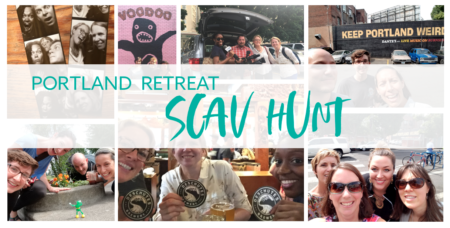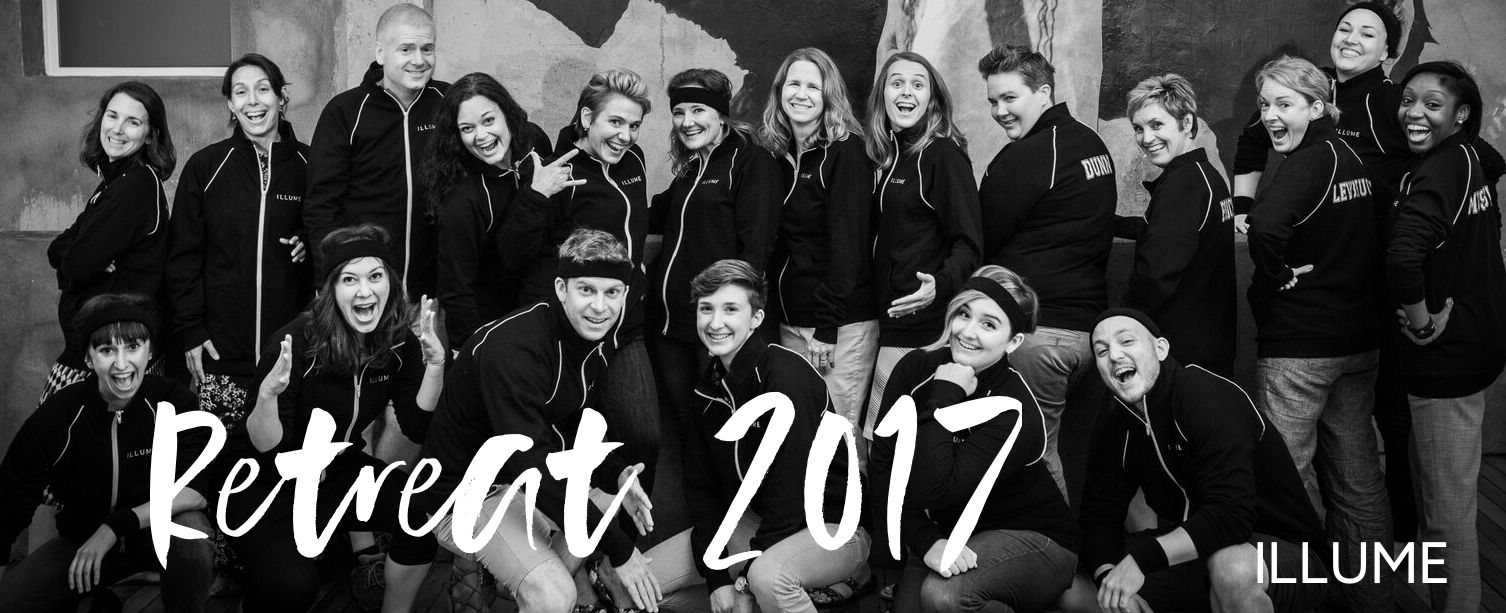
More and more companies are switching to models that include numerous offices and remote workers. For example, at ILLUME our headquarters are in Madison, but we also have offices in Tucson and Portland as well as remote employees spread across the country from Truckee, California to Washington, DC. For the most part, this system works well. Over the last few years, there has been a blossoming of technological tools that help facilitate real-time and personal communication. For example, our team found that using the chat-app Slack was a great improvement over email for keeping in touch with all those small things that foster a team’s sense of community—from first days of school to funny weekend anecdotes. However, this modern model has its downsides. There is always a little something, however, that is lost in digital translation despite

technological developments. To address this subtle je ne sais quoi that is lost when teams are not physically located near each other to meet up regularly, many organizations, including ILLUME, opt for multi-day off-site retreats. However, the cost of travel and loss of billable hours is a sizeable financial investment and owners must proceed thoughtfully. Here I would like to lay out a few benefits of a retreat strategy and also provide guidance for business owners to ensure this approach is a success and produces the maximum amount of benefit for the investment.
WHY
A recent article in the Journal of Applied Behavioral Studies, Effects of Positive Practices on Organizational Effectiveness boiled down the effects of a positive work environment into three primary impacts on organizational success. When employees feel cared for as individuals–outside of their work capacity–they are more likely to work more effectively and, interestingly enough, arrive at more creative solutions. Such employees are also more likely to recover more quickly from stress and stay with the organization longer. As a business owner I have to ask myself, what is the bottom line value of rich team cohesion? In day-to-day examples, we can think of a million small interactions that can quickly add up. How many hours are saved if someone would reach out for help at the first sign of a hiccup before it spirals into a huge problem? What about if team members are comfortable just picking up the phone, rather than limiting communication to endless email chains? What about the numerous training and loss of productive hours caused by high turnover? A successful retreat builds the type of high-quality collegial friendships—friendships based on trust, compassion, kindness, respect and- dare I say joy—that help employees feel their work is meaningful and fulfilling for the long term.
How
Not all retreats are created equally. If poorly thought-out, retreats can backfire. A bad retreat, best case scenario, leads to wasted time and resources with marginally annoyed employees. Worst-case scenario a bad retreat can exacerbate tension within the company and deepen mistrust and dissatisfaction. My partner and I have put significant thought into how we run retreats and I can offer four tips for a successful retreat.
Delegate portions of content to upcoming leaders in the company. The owners should not be talking the entire time. Not only do you run the risk of boring your team to tears, but even worse you are missing an invaluable opportunity to help develop leaders on your team in a structured way. Oversee the content for accuracy, but give your team room to structure their sessions. Encourage creativity. Go-getters will appreciate the opportunity to flex their leadership muscles and owners get the chance to see their team in action. Other benefits include a bump in receptivity (folks tend to be more receptive to peers or near peers for behavioral changes) and the well-established practice-what-you-preach behavioral intervention will improve adherence to norms among the leadership. In addition to leading whole-group sessions, delegate leaders to facilitate smaller group conversations to help build team solidarity by department or role.
Play, but with a purpose.
If your team is filled with smart achievers, they are likely to be underwhelmed by “trust falls” and the like- however play is a valuable learning tool. Absolutely use creativity and humor and play throughout the retreat—but be intentional with what you are hoping to get out of the games. In our last retreat, for example, we crafted a game to teach problem-solving in realistic challenges with clients. We strategically built mixed teams with more experienced and newer employees to maximize the modeling potential. We made the activity more playful by creating life-sized cut outs of “customers” and nominated some of our more outgoing folks to dramatize the interactions with a little humor. The content and training was invaluable, but it was also fun and engaging. Other ideas include jeopardy, scavenger hunts, and Pictionary. Spend time considering teams- think through the balance of outgoing with more reserved members, members who might not get to interact regularly, and personal skill sets. Considering these details before hand will help maximize the impact of play.

Leave unstructured time.
There is an immense pressure to fill every moment with content, however doing so will decrease one of the greatest reasons for a retreat- relationship building. Unstructured time hanging out around a BBQ, playing Frisbee, chatting during Happy Hour allows your team to build friendships. Before the retreat, brainstorm every possible content area you want to communicate at the retreat. Expect to cut this list in half and then really think through how your unstructured time can be enhanced. Think about how personalities on your team will respond to unstructured time. Will there be a rush to computers to squeeze in some emails? Should you ask people to leave their technology off? Will some of your team mill around uncomfortably? How can you draw forward the less outgoing or newer team members? Can you ask key members on your team to “be their buddy” so that these unstructured times led to connection and friendship?
Get out of the room.
Depending on the culture and stage of your company, it may be appropriate to allocate a time for the owners to leave the room and give the team time to have frank and honest conversations they might not feel fully comfortable having while the owners are in the room. In our last retreat, we allocated time for the topic “Managing Up: How to Work Effectively with Your (Sometimes Challenging) Supervisors”. Supervisors left the room and the session was facilitated by a trusted individual who was not only highly skilled in managing up, but also excellent at facilitating honest and productive conversations. Contextualizing supervisors as humans with strengths, but also foibles builds company empathy. Contextualizing the supervisor-supervisee relationship as one in which the supervisee is not helpless but rather empowered to employ strategies and tactics to improve the relationship, build skills and nips dissatisfaction in the bud. These benefits are well worth the somewhat vulnerable move of stepping out of the picture for an hour or so. There is a very large caveat to this strategy. If there are large tensions in your company, a company-wide vent session will not likely lead to improved satisfaction or better relationships. In this case, owners should address these tensions head-on and model their ability to listen and receive negative feedback.
Regular retreats, whether annual or biannual, hold the potential to dramatically improve employee satisfaction and positivity, which in turn, improve efficiency and output. You will see a reduction in counterproductive in-fighting, loss of productivity due to stress overloads and burnout, an increase in team members stepping up and helping each other out of challenges, less turn over, and overall a more creative and energized team. When you and your team see one another as whole beings— beings with strengths, growth-areas, and passions, beings with unique triggers and senses of humor—your team will sustain a vibrant and enjoyable work community through challenges and successes.

